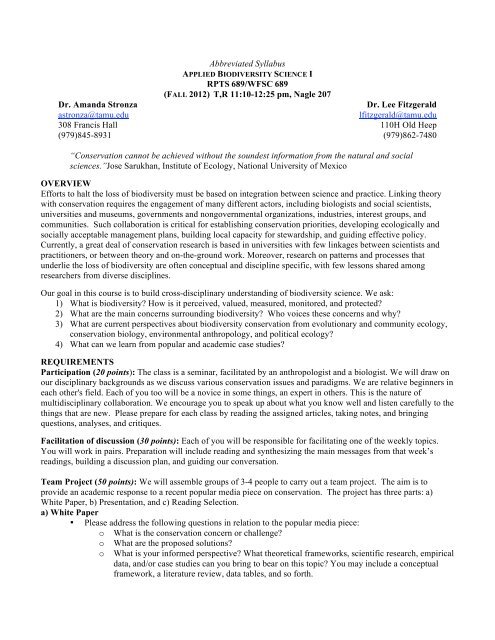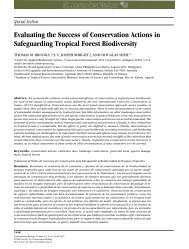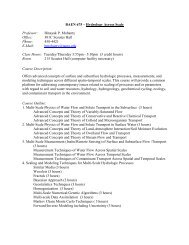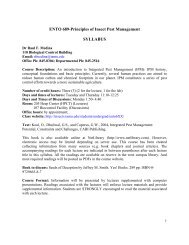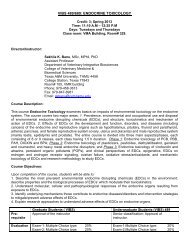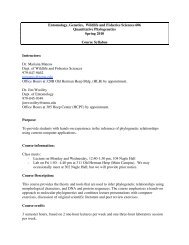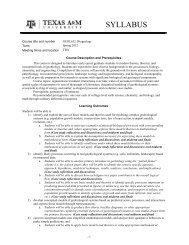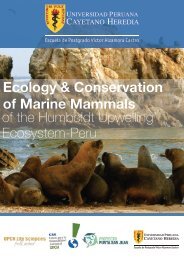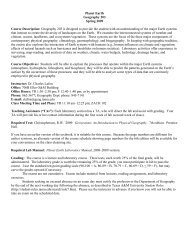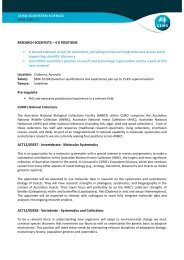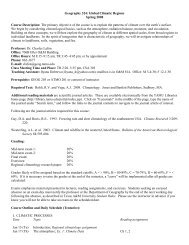pdf syllabus - Ecology and Evolutionary Biology
pdf syllabus - Ecology and Evolutionary Biology
pdf syllabus - Ecology and Evolutionary Biology
You also want an ePaper? Increase the reach of your titles
YUMPU automatically turns print PDFs into web optimized ePapers that Google loves.
Dr. Am<strong>and</strong>a Stronza<br />
astronza@tamu.edu<br />
308 Francis Hall<br />
(979)845-8931<br />
Abbreviated Syllabus<br />
APPLIED BIODIVERSITY SCIENCE I<br />
RPTS 689/WFSC 689<br />
(FALL 2012) T,R 11:10-12:25 pm, Nagle 207<br />
Dr. Lee Fitzgerald<br />
lfitzgerald@tamu.edu<br />
110H Old Heep<br />
(979)862-7480<br />
“Conservation cannot be achieved without the soundest information from the natural <strong>and</strong> social<br />
sciences.”Jose Sarukhan, Institute of <strong>Ecology</strong>, National University of Mexico<br />
OVERVIEW<br />
Efforts to halt the loss of biodiversity must be based on integration between science <strong>and</strong> practice. Linking theory<br />
with conservation requires the engagement of many different actors, including biologists <strong>and</strong> social scientists,<br />
universities <strong>and</strong> museums, governments <strong>and</strong> nongovernmental organizations, industries, interest groups, <strong>and</strong><br />
communities. Such collaboration is critical for establishing conservation priorities, developing ecologically <strong>and</strong><br />
socially acceptable management plans, building local capacity for stewardship, <strong>and</strong> guiding effective policy.<br />
Currently, a great deal of conservation research is based in universities with few linkages between scientists <strong>and</strong><br />
practitioners, or between theory <strong>and</strong> on-the-ground work. Moreover, research on patterns <strong>and</strong> processes that<br />
underlie the loss of biodiversity are often conceptual <strong>and</strong> discipline specific, with few lessons shared among<br />
researchers from diverse disciplines.<br />
Our goal in this course is to build cross-disciplinary underst<strong>and</strong>ing of biodiversity science. We ask:<br />
1) What is biodiversity? How is it perceived, valued, measured, monitored, <strong>and</strong> protected?<br />
2) What are the main concerns surrounding biodiversity? Who voices these concerns <strong>and</strong> why?<br />
3) What are current perspectives about biodiversity conservation from evolutionary <strong>and</strong> community ecology,<br />
conservation biology, environmental anthropology, <strong>and</strong> political ecology?<br />
4) What can we learn from popular <strong>and</strong> academic case studies?<br />
REQUIREMENTS<br />
Participation (20 points): The class is a seminar, facilitated by an anthropologist <strong>and</strong> a biologist. We will draw on<br />
our disciplinary backgrounds as we discuss various conservation issues <strong>and</strong> paradigms. We are relative beginners in<br />
each other's field. Each of you too will be a novice in some things, an expert in others. This is the nature of<br />
multidisciplinary collaboration. We encourage you to speak up about what you know well <strong>and</strong> listen carefully to the<br />
things that are new. Please prepare for each class by reading the assigned articles, taking notes, <strong>and</strong> bringing<br />
questions, analyses, <strong>and</strong> critiques.<br />
Facilitation of discussion (30 points): Each of you will be responsible for facilitating one of the weekly topics.<br />
You will work in pairs. Preparation will include reading <strong>and</strong> synthesizing the main messages from that week’s<br />
readings, building a discussion plan, <strong>and</strong> guiding our conversation.<br />
Team Project (50 points): We will assemble groups of 3-4 people to carry out a team project. The aim is to<br />
provide an academic response to a recent popular media piece on conservation. The project has three parts: a)<br />
White Paper, b) Presentation, <strong>and</strong> c) Reading Selection.<br />
a) White Paper<br />
• Please address the following questions in relation to the popular media piece:<br />
o What is the conservation concern or challenge?<br />
o What are the proposed solutions?<br />
o What is your informed perspective? What theoretical frameworks, scientific research, empirical<br />
data, <strong>and</strong>/or case studies can you bring to bear on this topic? You may include a conceptual<br />
framework, a literature review, data tables, <strong>and</strong> so forth.
Applied Biodiversity Science I RPTS/WFSC 689<br />
o What are the implications of your perspective for policy?<br />
• Limited to 10 pages, double-spaced, not including literature cited.<br />
• The series of “Working Papers” produced by the Wildlife Conservation Society may serve as a model<br />
for what you will write (http://archive.wcs.org/wcspubs/science.html) The first half of the following<br />
example may be especially useful: Casting for Conservation actors: people, partnerships <strong>and</strong> wildlife<br />
(http://archive.wcs.org/media/file/wcswp28.<strong>pdf</strong>)<br />
b) Presentation<br />
Each team has two class periods to cover the topic. You may devote some of the time to teaching the class<br />
about your conservation issue or presenting the topic generally. Be sure to allow enough time for seminar<br />
discussion as well.<br />
c) Reading Selection<br />
Two weeks before your team’s presentation, please provide the class with 2-3 articles we should read in<br />
preparation for the discussion.<br />
Grading: A=90-100 points, B=80-89 points, C=70-79 points, D=60-69 points, F=below 60 points<br />
d) Books: Contrasting perspectives on biodiversity conservation<br />
• We will select <strong>and</strong> read two books that discuss biodiversity conservation from a social science perspective<br />
<strong>and</strong> from an ecological science perspective. In the past we’ve read Song of the Dodo, by Quammen,<br />
Conservation Refugees by Dowie, Myth of Wild Africa by Adams <strong>and</strong> McShane, <strong>and</strong> Requiem for Nature<br />
by Terborgh.<br />
SCHEDULE<br />
INTRODUCTION<br />
Applied Biodiversity Science<br />
Defining <strong>and</strong> Measuring Biodiversity<br />
STUDENT-LED SEMINARS<br />
Cultural Diversity<br />
Assessment <strong>and</strong> Monitoring of Biological <strong>and</strong> Cultural Diversity<br />
Political <strong>Ecology</strong><br />
Crisis of Loss<br />
Questioning the Commons<br />
Setting Priorities<br />
TEAM PANELS AND DISCUSSIONS<br />
We will choose several controversial topics in biodiversity conservation,<br />
for example, wildlife trade, payments for ecosystem services, human-<br />
Conservation:<br />
wildlife conflict, community-based conservation, <strong>and</strong> many others.<br />
Popular <strong>and</strong> Academic<br />
Teams will dig deeply into the literature to learn what supports or<br />
refutes the way these subjects are portrayed in popular media.<br />
GUEST LECTURE<br />
Conservation <strong>and</strong> Citizen Science<br />
BOOK FORUM<br />
Contrasting viewpoints from two books<br />
EVALUATION<br />
Insights, lessons, new questions<br />
- 2 -


